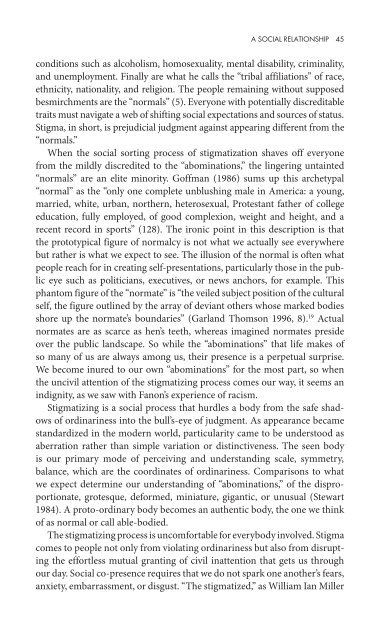Staring how we look sobre la mirada.pdf - artecolonial
Staring how we look sobre la mirada.pdf - artecolonial
Staring how we look sobre la mirada.pdf - artecolonial
You also want an ePaper? Increase the reach of your titles
YUMPU automatically turns print PDFs into web optimized ePapers that Google loves.
18 WHAT IS STARING?<br />
effects for both starer and staree that emanate from the neural automata and<br />
spread through the entire body.<br />
VISUAL THRILLS<br />
The question of what <strong>we</strong> stare at has a simple ans<strong>we</strong>r: <strong>we</strong> stare at what interests<br />
us. Things interest us, of course, for differing reasons and elicit stares<br />
with correspondingly varied goals. The schoolteacher tries to intimidate the<br />
unruly boy; the lover and the pilgrim seek to adore; the bored <strong>look</strong> for excitement;<br />
the scientist searches for truth. What interests us most, <strong>how</strong>ever,<br />
is novelty. For centuries people have known that the “mind always burns to<br />
hear and take in novelties.” 3 In his book on the science of satisfaction, the<br />
physician Gregory Berns (2005) exp<strong>la</strong>ins that brain imaging experiments<br />
s<strong>how</strong> the neurotransmitter dopamine flowing most fully when <strong>we</strong> experience<br />
novel events. Dopamine is the chemical that the brain releases in response<br />
to pleasure. The pleasure of novelty, the dopamine rush, comes from<br />
the “surprise” that stimu<strong>la</strong>tes the brain. Berns concludes that novelty is “the<br />
one thing <strong>we</strong> all want” (14). “You may not always like novelty,” Berns says,<br />
“but your brain does” (xiii). Searching for the pleasure novelty brings, <strong>we</strong><br />
do not seek a thing for itself but rather for the thrill of surprise it brings. So<br />
the snagging of our eyes by something unusual pumps out the dopamine,<br />
providing us pleasure.<br />
What is unusual, of course, depends upon what <strong>we</strong> expect to see. A<br />
common sight in one p<strong>la</strong>ce can be uncommon in another; as noted in the<br />
previous chapter, de Lotbiniere might not be stareable in a cancer ward.<br />
Social expectations shape our ocu<strong>la</strong>r sorting processes, making certain appearances<br />
and actions unusual and cataloging people as alien or native,<br />
extraordinary or ordinary. Zora Neale Hurston wrote, for instance, that she<br />
became “colored” only when she was surrounded by white people (1928).<br />
Gender expectations make the bald head of a woman indicate chemotherapy<br />
treatment whereas vie<strong>we</strong>rs might read the same smooth pate on a man<br />
as the stylish marking of a hip athlete. Simi<strong>la</strong>rly, a woman with enough<br />
facial hair to suggest a beard merits a stare while a man with a bushy beard<br />
is unremarkable.<br />
But the jolt of the unusual is fleeting. A dopamine rush inevitably ebbs<br />
as novelty diminishes. Novelty is fragile and staring vo<strong>la</strong>tile because the longer<br />
<strong>we</strong> <strong>look</strong>, the more accustomed a once surprising sight becomes. <strong>Staring</strong><br />
researcher and social psychologist Ellen J. Langer found that people stare at<br />
“novel stimuli” as a form of “exploratory behavior” (Langer et al. 1976, 461).<br />
The surprise that motivates staring produces, in other words, an expedition


